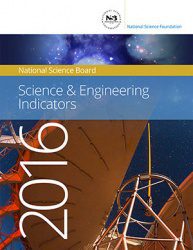The National Science Board recently released Science and Engineering Indicators (SEI) 2016, the premier source of quantitative information on the state of U.S. and international science, engineering, technology, and education. The report provides high-quality, objective data on a range of S&E indicators that help inform data-driven policy making. SRI managed the compilation of data for over 100 indicators and co-authored the State Indicators section with the NSF’s National Center for Science and Engineering Statistics (NCSES). Gathering, analyzing, and preparing the data and findings for review and release took a full year and leveraged the expertise of the SRI team in a variety of S&E topics, data sources, and delivery systems.
The topics in the report include:

- Elementary and Secondary Mathematics and Science Education
- Higher Education in Science and Engineering
- Science and Engineering Labor Force
- Research and Development: National Trends and International Comparisons
- Academic Research and Development
- Industry, Technology, and the Global Marketplace
- Science and Technology: Public Attitudes and Understanding
- State Indicators
State Indicators, which I co-authored with NSF staff, is both a section of the report as well as a visualization tool. The tool contains 58 S&E indicators for individual states, the District of Columbia, and Puerto Rico. The indicators can enable policymakers to assess trends in science and technology education, the S&E workforce, state funding levels for research and development, and research and development activity across states; the analysis covers the most recent 10-year period. The data used for each indicator were gathered from long standing and respected public and private sources, such as the National Center for Education Statistics, the Census Bureau, the Bureau of Economic Analysis, the Bureau of Labor Statistics, the College Board, and the PricewaterhouseCoopers MoneyTree TM Survey. SRI’s mix of public policy and S&E expertise allowed us to put the data in context and explain to readers the nuances behind the data in a policy-neutral way.
As we look to the next edition of the Indicators report, we are conducting research on new indicators to reflect timely trends in the S&E ecosystem. As with all of our projects, we strive to find new sources of data and new techniques for more comprehensive and precise measurements. A particular area of interest is in the measuring innovation, which historically has been difficult due to limited sources of data and incomplete conceptual frameworks. We are looking to expand the indicators in this area—and others—to help policy makers and organizations make better decisions about science and technology.


